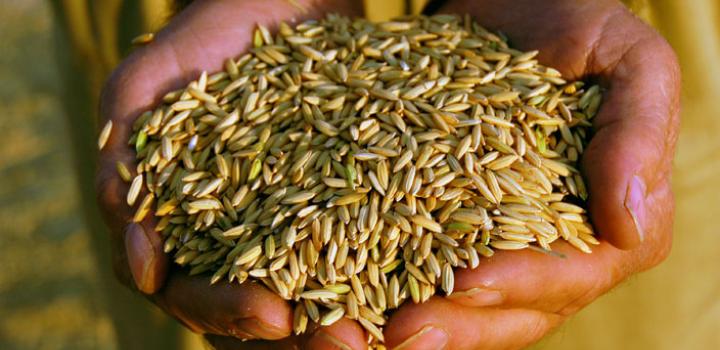Researchers say better rice quality will feed more people
by November 19, 2023 10:01 am 491 views

About 2.3 billion, or nearly 30%, of the world’s population doesn’t get enough to eat, according to the World Health Organization. Rice is by far the most consumed food in the world with it being a staple food for nearly half the human population.
With the global population expected to exceed 9 billion by the year 2050, farmers and food scientists will have to find ways to keep hunger numbers from growing. One way could be to more efficiently mill rice or grow rice that is better suited to be milled.
A 1% increase in unbroken rice kernels could mean millions more servings of this critical staple grain, increased food security around the globe and improved producer profitability, a study from two University of Arkansas researchers suggests. Professor Lanier Nalley and Associate Professor Alvaro Durand-Morat, both in the agricultural economics and agribusiness department, conduct research for the Arkansas Agricultural Experiment Station.
Their study estimated the impact of improving rice milling yields using harvest data from 2004 to 2020. Their aim was to understand the food security implications of milling quality. With a 1% increase in unbroken rice kernels after milling, Nalley and Durand-Morat calculated that Arkansas, the nation’s top rice-growing state, could hypothetically produce up to 0.89-1.05 million more servings of rice annually without increasing yield or production inputs. In another scenario, they estimate Arkansas could produce up to 3.5 million more servings annually if all rice grown was set to a minimum benchmark milling yield potential based on a popular purebred University of Arkansas System Division of Agriculture variety.
When it comes to rice breeding, “everyone wants quantity, but quality is also important,” Nalley said. In terms of this study, “quality” means rice grains that resist breaking during the milling process.
“Improving rice quality by reducing the amount of broken rice will result in more rice reaching consumers rather than being used for other non-food uses,” Nalley said. “If we can improve genetics for quality, we’re getting more and more rice going to humans.”
Calculations of milling yield include the head rice yield, which is the percentage of whole kernels over the total whole and broken milled kernels. When rice is harvested from the field, the rice grains are encased in an inedible hull and covered by a bran layer, Nalley said. Milling removes the hull and bran layer to reveal the white rice grain. Milling yield is the percentage of polished white rice obtained from milling the rice harvested directly from the field.
The researchers wanted to measure the economic impact of rice quality. To do this, they simulated the increase of the number of whole milled kernels rather than raising the yield ceiling by increasing paddy yield, which is the number of freshly harvested rice grains.
Arkansas was the top rice-producing U.S. state in 2022. U.S. Department of Agriculture data shows that Arkansas produced roughly half of U.S. rice production last year. Arkansas rice feeds people living in some of the poorest countries in the Western Hemisphere, such as Haiti, which is the largest importer of Arkansas rice, Nalley said.
Rice breaks during milling for many reasons, such as environmental and weather-related or genetic causes, Nalley said. He said his research focused on how growing higher-quality rice could feed more people worldwide and improve the bottom line for Arkansas producers. Less broken rice could generate higher profit margins for farmers.
Producers profit from rice based on how much they yield and the number of whole kernels after milling, Nalley said. Broken kernels receive a discounted price, from 50% to 72% of the value of whole kernels. Broken kernels also end up in alternative markets, such as the pet food and beer brewing industries. The markets that accept broken kernels for human consumption, such as some West African nations, are quickly saturated, Nalley added.
“Increasing quality will increase producer profitability, and it gets rice into some of the poorest people’s stomachs in the world,” Nalley said.
To illustrate the possibilities of increased rice milling yields due to improved rice genetics, Nalley and Durand-Morat considered two theoretical scenarios. The 1% marginal increase in head rice yield that resulted in up to 1.05 million more rice servings, and a scenario based on setting a minimum milling yield potential. The researchers selected Roy J, a purebred Arkansas rice variety developed by Karen Moldenhauer, professor and rice breeder emeritus, as the minimum milling standard.
Using Arkansas rice acreage data from 2004-2020, along with yearly variety-specific yield and milling rates from the Arkansas Rice Performance Trials, Nalley calculated the hypothetical increase in head rice yield for each variety harvested in Arkansas. For example, the head rice yield of Roy J in 2015 was 61%. The researchers artificially set 61% as the minimum head rice yield for all varieties grown in Arkansas in 2015 and calculated the resulting increase in milling yield for that year. The researchers input the hypothetical milling yield values from 2004-2020 into a model that assessed the cumulative impact of the increased head rice on the market. They found that setting a minimum milling yield to match Roy J could increase the number of rice rations produced in Arkansas between 2.94 and 3.5 million annually. This corresponds to an average of $24.48 million in potential annual economic value added to the state.
High-yielding rice varieties are popular with producers, Nalley said, but this research shows the potential benefits of also breeding for improved milling quality.
“The golden goose is to increase yield,” Nalley said. “Ideally, you would increase yield and simultaneously increase quality, but that’s like patting your head and rubbing your stomach at the same time — it’s hard to do.”
